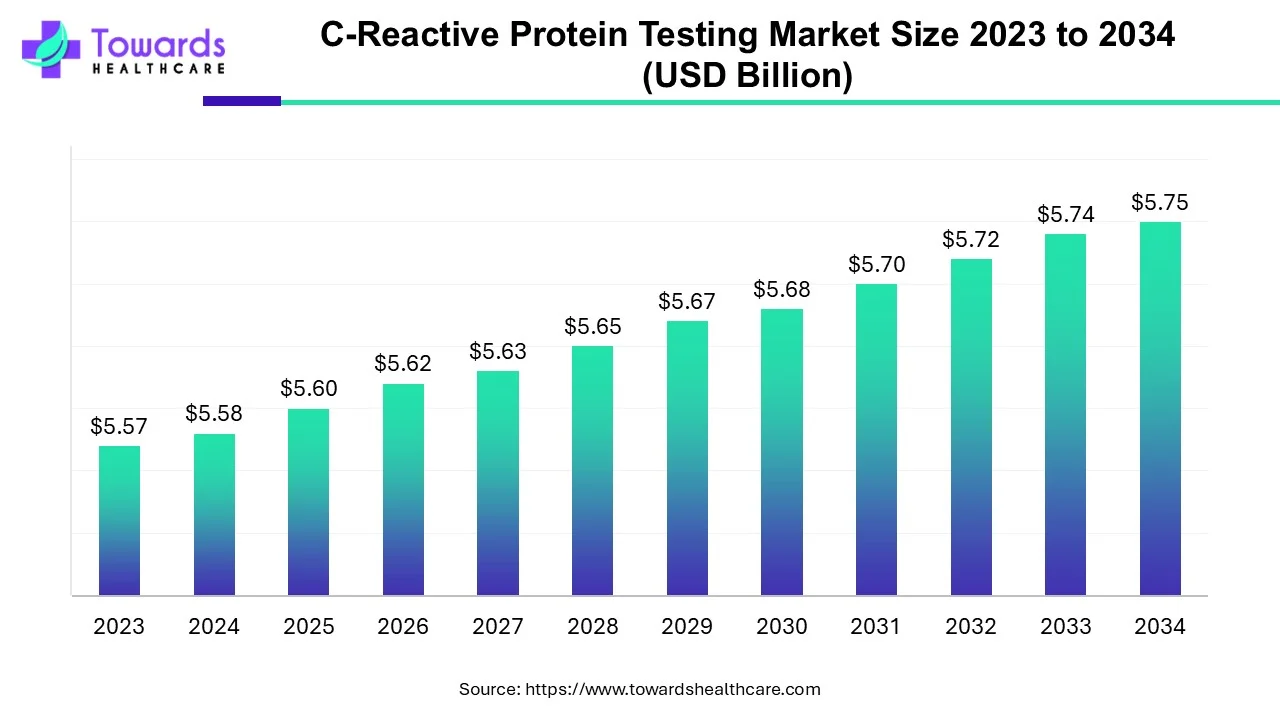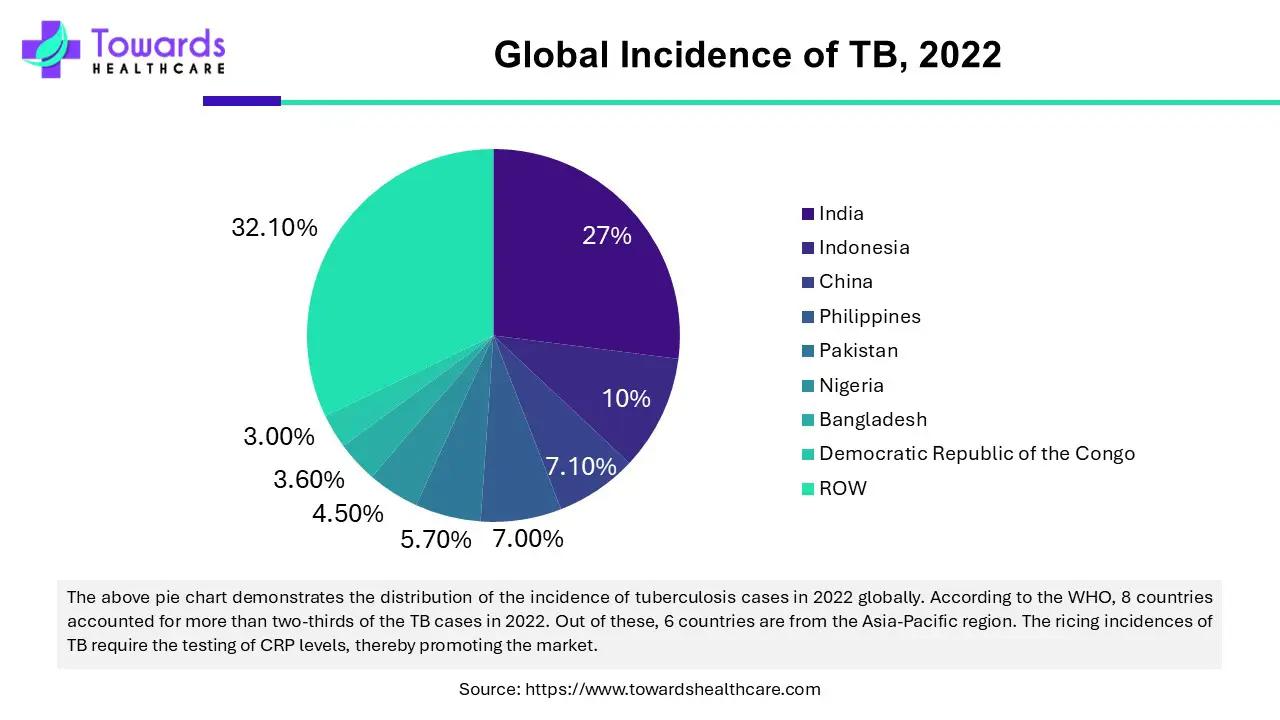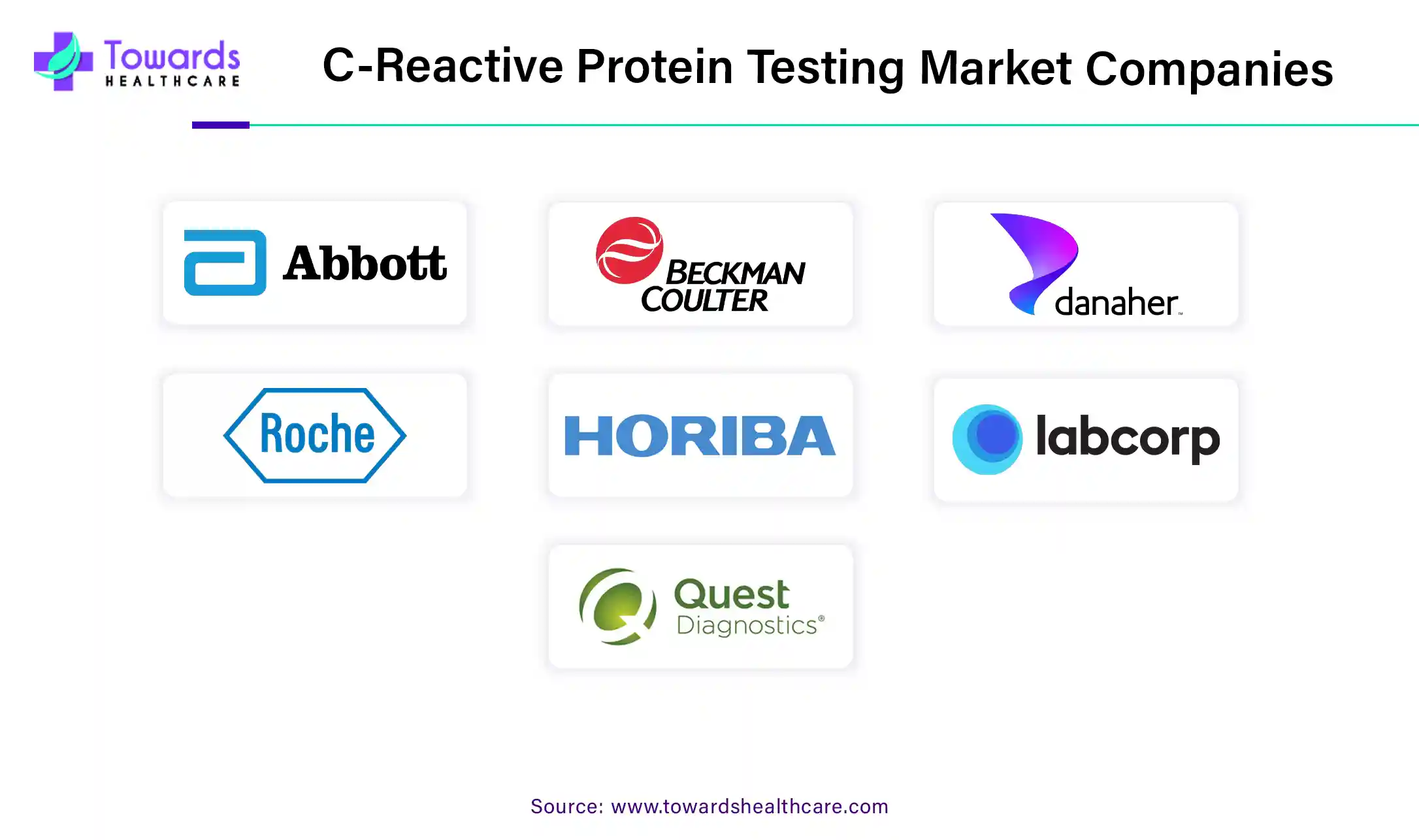November 2025

The global C-reactive protein testing market size is calculated at USD 5.58 billion in 2024, grew to USD 5.6 billion in 2025, and is projected to reach around USD 5.75 billion by 2034. The market is expanding at a CAGR of 0.3% between 2024 and 2034. The rising incidences of acute and chronic inflammation, technological advancements, and growing demand for point-of-care diagnostics drive the market.

A C-reactive protein test is a laboratory test that measures the presence of C-reactive proteins (CRP) in the blood. CRP is produced by the liver in response to inflammation in the body. Inflammation can be caused due to any acute or chronic disorder such as bacterial or viral infections, inflammatory bowel disease, autoimmune disorders, and lung diseases. A CRP test can predict whether there is inflammation in the body and how much. There are generally two types of tests: standard CRP test and high-sensitive CRP test. A high-sensitivity CRP test is more sensitive than a standard test as it can measure even a minute increase in CRP levels. It can predict the risk of getting coronary artery disease.
The rising incidences of acute and chronic inflammation conditions due to several reasons increase the demand for CRP tests. The increasing geriatric population and the need for advanced healthcare services also potentiate the market. Additionally, technological advancements to increase the efficiency of test results boost market growth.
Artificial intelligence (AI) has numerous benefits in the diagnostics field. Efforts are made to incorporate AI for the detection of CRP levels. Several researchers are investigating alternative testing methods to detect CRP using AI. The advent of sensors helps in detecting CRP levels. Sensors are a non-invasive approach to measure accurate levels of CRP within the body. AI-enabled algorithms can predict the future risk of severe chronic disorders. AI can also detect the cause of high levels of CRP and can identify the disease condition. The use of machine learning in blood test result analysis could enhance the ability to distinguish between viral and bacterial illnesses and, as a result, optimize the prescription of antibiotics. Hence, implementing AI for CRP testing significantly enhances the sensitivity and accuracy and reduces the overall time of the test.
For instance,
Antimicrobial Resistance: The rapid genetic mutations in bacteria, viruses, and pathogens result in no response to antibiotics, causing antimicrobial resistance (AMR). AMR is a major public health concern globally, owing to the increasing risk of bacterial and viral infections. The World Health Organization (WHO) also releases several guidelines for screening and tackling AMR among individuals. WHO has declared AMR as one of the top 10 global health threats. WHO collaborates with several government agencies and other organizations to help reduce AMR. As of November 2023, 178 countries had developed AMR national action plans aligned with the Global Action Plan (GAP). CRP testing may help reduce antibiotic overprescribing. The gradual decrease in CRP levels can be monitored in patients since the bacterial inflammatory factors are eliminated. CRP testing aids the management of respiratory infections and the fight against AMR.
Lack of Specificity: The major challenge of the c-reactive protein testing market is the lack of specificity. CRP test can measure CRP levels in humans, thereby indicating the presence of inflammation. However, it cannot identify the exact cause of inflammation. This restricts the market growth and increases the demand for testing procedures to identify the underlying cause of inflammation.
Growing Point-of-Care Diagnostics Demand: The demand for point-of-care (PoC) diagnostics is rising rapidly to provide real-time diagnostic information about a patient. The COVID-19 pandemic highlighted the significance of PoC. PoC is useful in diagnosis, accurate monitoring, early detection, and the prevention and management of chronic conditions. Several government organizations and industry leaders promote PoC tests. The Indian government has recognized the importance of PoC diagnostics in improving healthcare outcomes and has taken steps to promote the use of these technologies. Additionally, many countries in Europe have routinely implemented the use of PoC testing for CRP in primary care. CRP-PoC test is widely used in many countries to help clinicians identify respiratory tract infections in patients. Hence, the growing demand for PoC diagnostics presents a remarkable opportunity for the c-reactive protein testing market.
By assay type, the immunoturbidimetric assay segment registered its dominance over the global C-reactive protein testing market in 2023. Immunoturbidimetric assay or immunoturbidimetry is a test that measures a sample’s turbidity to determine the level of analyte. The formation of the CRP-antibody complex increases the turbidity of the sample. The amount of turbidity quantifies the level of CRP in the sample. It is most widely preferred for testing CRP as it is a fast, reliable, cost-effective, and accurate method. Also, it does not require complex instrumentation. Technological advancements further potentiate the segment’s growth.
By assay type, the ELISA segment is predicted to witness significant growth in the c-reactive protein testing market over the forecast period. Solid-phase sandwich ELISA (enzyme-linked immunosorbent assay) is used for measuring CRP levels in human serum and plasma. It is highly preferred due to its high sensitivity and specificity. ELISA can recognize both natural and recombinant CRP levels. ELISA test is commonly preferred by researchers to monitor CRP levels.
By detection range, the hs-CRP segment led the global C-reactive protein testing market in 2023. High-sensitivity CRP (hs-CRP) is a type of CRP test that measures even a minute quantity of CRP levels in blood samples. Because of this high sensitivity, hs-CRP can predict the risk of cardiovascular disease. It may be used in combination with other tests to provide additional information about heart disease risk. It can measure CRP in the range from 0.3 to 1.0 mg/L. This test is most useful for individuals having a 10% to 20% chance of having a cardiac event within a decade.
By detection range, the conventional CRP segment will gain lucrative growth in the market over the studied period. The demand is rising due to the increasing incidences of acute and chronic conditions, growing healthcare services, and increasing awareness.
By disease area, the cardiovascular diseases segment held a dominant presence in the C-reactive protein testing market in 2023. The increasing incidences and prevalence of cardiovascular diseases (CVD) and demand for early detection boost market growth. CVDs are the leading cause of death globally. In 2022, 702,880 people in the US died from heart disease. CRP tests can predict the risk of CVD in individuals. According to a 2024 study, the highest levels of CRP had a 70% increased risk of CVD and it can predict 30-year CVD risk for women. The availability of hs-CRP tests and the growing demand for PoC diagnostics augment the segment’s growth.
By disease area, the cancer segment is expected to grow at the fastest rate in the market during the forecast period. The demand is increasing due to rising incidences of cancer globally and the complexity of the disease. Globally, around 20 million new cancer cases were reported in 2022. CRP levels act as early biomarkers in predicting the onset of cancer.
By end-use, the hospital segment dominated the C-reactive protein testing market in 2023. The segment’s growth is attributed to the increasing number of patients, suitable advanced facilities, and the presence of skilled professionals to perform CRP tests. The increasing number of surgeries also promotes the segment’s growth as CRP levels are also measured to monitor patients after surgeries or invasive procedures.
By end-use, the clinics segment is projected to grow significantly in the market in the coming years. Clinics are the first choice for patients having minor symptoms as they are the most accessible and more convenient. The increasing demand for PoC diagnostics and affordable test kits drives the segment’s growth.
North America held the largest share of the C-reactive protein testing market in 2023. The increasing awareness for preventive care, technological advancements, and increasing laboratory tests drive the market. More than 7 billion blood tests are performed in the US annually. Several government organizations such as the National Institute of Environmental Health Sciences support numerous research projects focused on inflammation and its role in health and wellness. The increasing incidences of chronic disorders also augment market growth. In Canada, it is estimated that 825 per 100,000 individuals, i.e. around 320,000 people suffer from inflammatory bowel disease (IBD) in 2023. The market is also driven by the presence of key players and a supportive regulatory framework.
Asia-Pacific is expected to grow at the fastest rate in the c-reactive protein testing market during the forecast period. The rising incidences of acute and chronic inflammatory disorders, increasing demand for PoC diagnostics, and favorable government policies boost the market. In India, it is estimated that 25% of the total population does regular health checkups. The prevalence rate of ulcerative colitis in Asia is around 20-101 per 100,000 population. Tuberculosis is the most common bacterial infection and a leading cause of death globally. According to the WHO, around 10.6 million people reported TB in 2022 globally.


Dr. Paul M. Ridker, MD, Harvard Medical School, in an interview, highlighted the significance of the high-sensitivity CRP (hs-CRP) test as a risk marker for various forms of cardiovascular disease. He said that the increased levels of hs-CRP in healthy individuals are predictive of the future risk of a heart attack, stroke, sudden cardiac death, and peripheral arterial disease, even when the cholesterol levels are low.
By Assay Type
By Detection Range
By Disease Area
By End-Use
By Region
November 2025
November 2025
October 2025
September 2025